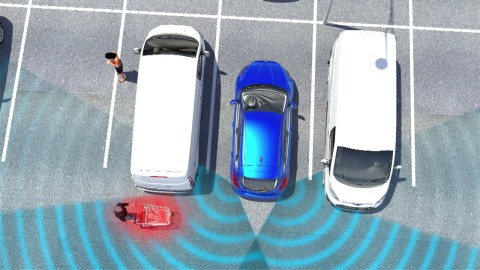- Ford investments in next-gen driver assist technology will deliver new features that make parking less stressful and enable drivers to park in spaces they wouldn’t otherwise consider
- Further new technologies help drivers steer around slow or stopping vehicles in emergencies and warn drivers going the wrong way down the motorway
- New systems build on wide-ranging technologies already offered on Ford vehicles that help drivers with parking, collision avoidance, lane keeping, speed management and more
BRENTWOOD, Essex, 3 November, 2016 – Nerve-wracking, potentially hazardous and a significant contributor to repair bills for low-speed bumps and scrapes – parking is a pet-hate for drivers everywhere.
In the U.K., a quarter of accidents occur in car parks.1 Almost half of drivers say they would rather travel further from their destination than attempt to parallel park.2
Cross-traffic alert with braking technology in development at Ford is being designed to help reduce parking stress by detecting people and objects about to pass behind the vehicle, providing a warning to the driver and then automatically braking if the driver does not respond. Rear wide-view camera, on the in-car display, will offer an alternative wide-angle view of the rear of the vehicle. Enhanced active park assist will parallel or perpendicular park at the push of a button.
“We’ve all become accustomed to the challenges of driving, but it remains one of the most demanding tasks most of us perform day in, day out,” said Torsten Wey, manager, Chassis & Safety Electronics, Ford of Europe. “Technology is already proving its potential to help make driving less stressful – and Ford’s investment in research and development is paying off by accelerating innovation to expand our portfolio of driver-assist technologies that deliver functionality and performance that customers will value.”
Further technologies developed at the Ford European Research and Innovation Center in Aachen, Germany, include systems designed to help drivers steer around other vehicles to help avoid high speed collisions, and to warn drivers from travelling the wrong way down motorways.
These new technologies – expected to be first made available on Ford vehicles in the next two years, are part of the company’s commitment to triple its investment in developing driver assist features, to evolve them further and to expand their capabilities, speeding the roll-out of systems that make it easier to park and drive in heavy traffic, and help drivers avoid collisions.
“Drivers must remain alert and reactive when behind the wheel but driver assist technology can help,” said Edmund King OBE, president, the Automobile Association. “There are great benefits in Ford developing new assist technologies which can aid the driver to avoid collisions, spot vulnerable road-users in blind spots or eradicate parking rage by making parking easier.”
Taking the stress out of parking
In the U.K, car park related accidents account for a one in every four accidents1 and cost drivers around £716 million in repair bills each year.3 During the past 20 years, the width of cars has increased by around 16 per cent but many parking spaces remain the same size.3
Research also shows that 47 per cent of drivers park further away from their destination to avoid parallel parking, 15 per cent avoid parallel parking completely, and 75 per cent of drivers get nervous when having to park in front of other drivers.2
“Parking is one of the most stressful experiences behind the wheel, and drivers struggling to find suitable parking spaces in urban areas can have a knock-on effect for traffic flow as well as stress-levels,” said Dirk Gunia, supervisor, Driver Assist Electronics, Ford of Europe. “Technologies like our enhanced active park assist will help drivers feel confident about parking in spaces they might otherwise have considered too small.”
Enhanced active park assist controls steering, gear selection and forward and reverse motion to facilitate parking at a push of a button. The system can automatically enter and exit a parallel parking space, and can reverse the vehicle into a perpendicular space. Enhanced Active Park Assist also uses sensors to locate suitable parking spaces.
Cross Traffic Alert with Braking uses radar sensors to monitor the area behind the vehicle. If the driver is backing out and does not react to the initial warning, the system is designed to automatically apply the brakes. The system is being designed to detect motorcycles and bicycles.
Rear wide-view Camera displays a wide-angle view from the rear of the vehicle on the in-car display, to offer a similar functionality to Ford’s Front Wide View Camera located at the front of the Ford Edge, Galaxy and S-MAX models. When reversing, it provides an additional view that enables drivers to see around corners as well as obstacles and objects approaching from behind the vehicle.
Steering out of trouble
Ford also is developing new technology that could help drivers steer around stopped or slower vehicles to help avoid collisions.
Designed to operate at city and highway speeds, evasive steering assist uses radar and a camera to detect slower moving and stationary vehicles ahead and provides steering support to enable drivers to help avoid a vehicle if a collision is imminent.
The system is activated if there is insufficient space to avoid a collision by braking only and the driver decides to take evasive action. Evasive steering assist builds on existing Forward Collision Warning technology, and Pre-Collision Assist, which reduces the severity of some frontal collisions involving vehicles and pedestrians, or help drivers avoid some impacts altogether.
“As soon as the driver tries to steer around a slower car in an emergency, evasive steering assist activates to help execute the evasive manoeuvre by making it easier to perform quick steering movements,” said Peter Zegelaar, technical expert brake controls, Automated Driving, Ford of Europe.
Wrong-way driving warning
It’s every driver’s worst nightmare and Ford is developing technology that could help stop it from happening − to warn drivers from entering the motorway from the wrong direction.
Wrong way crashes are more likely to produce serious injuries and fatalities compared with other collisions. In Germany, three per cent of fatal accidents on motorways are caused by people driving the wrong way, accounting for around 20 fatalities each year.4
Wrong Way Alert uses a windscreen mounted camera and information from the car’s navigation system to provide drivers with audible and visual warnings when driving through two “No Entry” signs on a motorway ramp. The system – first available for customers in Germany, Austria and Switzerland – builds on Traffic Sign Recognition that uses a forward-facing windscreen‑mounted camera to scan the environment for road signs and alert the driver to their presence. Wrong Way Alert uses the camera and the navigation system to help warn drivers to stop or turn around.
Traffic Jam Assist is a further technology previously announced by Ford, and expected to first arrive for customers within two years. The system assists the driver in keeping the vehicle centred in the lane and brakes and accelerates to keep pace with the vehicle in front
Longer term, Ford is also developing a Camera-Based Advanced Front Lighting System that widens the headlight beam at junctions and roundabouts after interpreting traffic signs.
Leading the way in driver assist technology
Ford is already a leader in democratising driver assistance technologies; in Europe, Ford has been offering a broad portfolio of features for mass-market customers for many years including:
- Pre-Collision Assist with Pedestrian Detection
- Intelligent Speed Limiter, which when activated scans traffic signs and adjusts the throttle to help drivers stay within legal speed limits and avoid fines
- Glare-Free Highbeam, which uses a windshield-mounted camera to detect the headlights or taillights of bicycles up to 100m away, motorcycles up to 400m away and cars up to 800m away at night, and uses specially developed headlights to block light that could otherwise temporarily blind other drivers and cyclists
- Ford’s Adaptive Front Lighting System, which adjusts the headlight beam angle and intensity to match the driving environment, including a Weather-Dependent Lighting mode that automatically adjusts headlights to help drivers spot roadside hazards in extreme heavy rain
Ford drivers have for some time also benefitted from parking technologies including:
- Perpendicular Parking, which can detect and reverse the car hands-free into spaces alongside other cars in the same way that Active Park Assist helps drivers to parallel park
- Park-Out Assist, which helps drivers exit a parallel parking space, the system operating the steering while the driver operates the accelerator and brake
- Side Parking Aid, which delivers audible alerts and on-screen distance indicators to obstacles around the vehicle
- Cross Traffic Alert, which warns drivers reversing out of a parking space of vehicles that may soon be crossing behind them
Further driver assistance technologies include Adaptive Cruise Control, Blind Spot Information System, Traffic Sign Recognition, Lane Keeping Alert, Lane Keeping Aid and Driver Alert.





